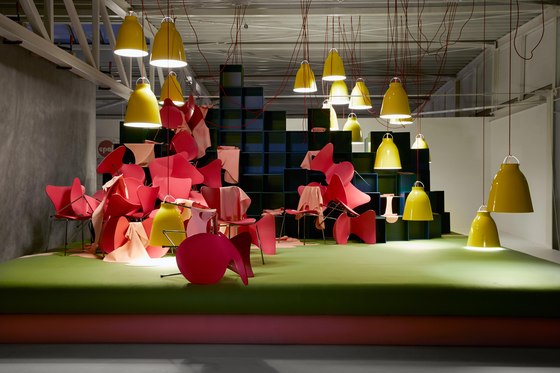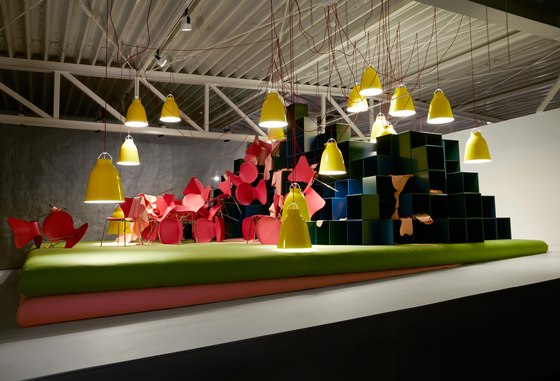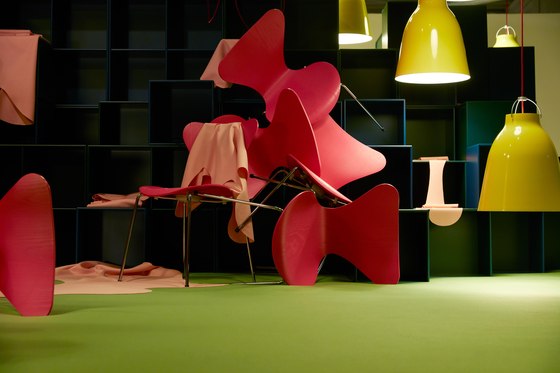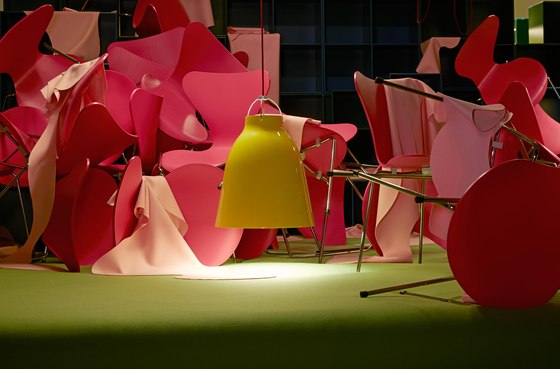For its 40th anniversary the Icelandic design emporium Epal commissioned two artists, Danish painter Eske Kath and Icelandic conceptual artist Haraldur Jónsson, to create two installations on its premises. These installations were opened to the public on October 2nd and will form part of the Epal shop until the end of the year. Events of this kind, interdisciplinary happenings and art projects, have long been a part of the shopʽs celebratory traditions.
Eske Kath, who has just turned forty, is among the most celebrated artists of his generation in Denmark. His paintings are to be found in Denmarkʽs major museums, some of that countryʽs most prestigious galleries vie to present his works and presently American galleries have taken him under their wing. Kath is now living in Brooklyn, New York. Publicly he is probably best known for a ceiling decoration executed in Amalienborg Palace (2009), commissioned by its residents, Crown Prince Frederik and Crown Princess Mary. Kathʽs colourful and elaborately structured works represent scenes of chaos and natural disasters, highlighting the fragilty of our civilization.
Kath frequently uses architectural elements or man-made objects as signifiers for a culture under threat. This is one reason why the artist was approached by Epalʽs proprietor, Eyjólfur Pálsson, and asked to create a large-scale installation using a set of iconic design objects and material by some of Denmark´s most famous designers. The four designer objects chosen by Pálsson for a „makeover“ were the Caravaggio lamp from the Lightyears firm, Arne Jacobsenʽs ubiquitous 3107 chair, Montanaʽs shelving system and textiles from Kvadrat, all of which have been marketed by Epal for decades. Needless to say, the manufacturers all cooperated in this unusual venture.
In his treatment of Fritz Hansenʽs Jacobsen chairs, the centerpiece of his proposed installation or „stage design“, Kath chose to bypass the „regular“ commercial colours assigned to them. Instead he had the Fritz Hansen firm make up a special colour from the Pantone range, which accorded with the colour range found in his paintings. The chairs were then stacked up or assembled on or in front of what Kath calls the „Montana landscape“, an arrangement of black shelves, which nestle on a soft bed of green fabric, reminiscent of Icelandic moss. Scattered on the „rock face“ of the shelves as well as the edges of the scattered chairs are irregularly shaped pieces of pink cloth, courtesy of Kvadrat, evoking the colour of skin. Hovering over and around the whole assemblage like so many suns are the large yellow Caravaggio lamps, completing the landscape analogy. At the same time Kath makes it patently clear, by means of a broad pink ribbon encircling the green „stage“, that his creation is an artifice rather than a doomsday prediction.
In conversation Kath is quite open about the landscape analogy. „ I started out by looking for a cloth for the base of the installation that would bring to mind the colour and texture of Icelandic moss. The black shelves resting on it can also be seen as a reference to Icelandic basalt geology. In addition to the pink cloth from Kvadrat, the chairs – like the houses in my paintings – are surrogates for the human body, swept hither and thither within an unstable or even cataclysmic space. In its entirety the installation can be seen as a comment on the vulnerability of the Icelandic landscape and human existence as a whole.“
Kath welcomed the challenge represented by the Epal installation. „I havenʽt tackled a project quite like this one before. In my art, my choices are virtually unlimited. In this case I had to accept certain limitation, both with regard to structure, colour range and number of elements. I had to work within those parameters to achieve something that I felt to be true to my artistic convictions. But parameters are often good for you. You have to be extra resourceful to get the most out of them. Same as with life itself.“
Finally, Kath was asked about his own exposure to classic Danish design. „I have to admit that I havenʽt been very involved with it personally. But like so many others of my generation I was exposed to a lot of design through my parents and grandparents. My own furniture, such as it is, is a fairly eclectic collection, serving different needs.“
The items that make up Eske Kathʽs Epal installation, 160 „modified“ designer objects in all, will be marketed in a limited edition which will not be reissued. Customers who buy items from this edition will in addition be presented with a high-quality photograph featuring the complete installation.








